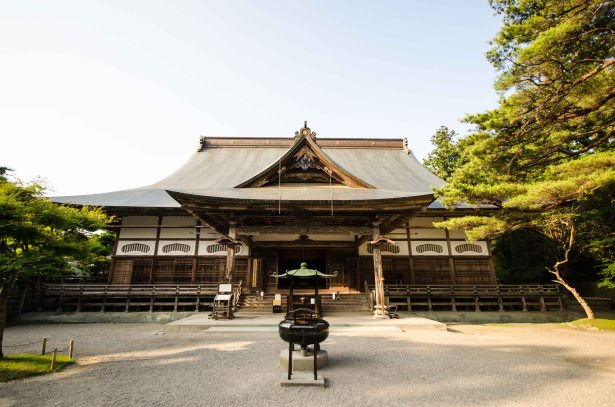These last three days have been a veritable smorgasbord of Basho-based visitations. While I wait for my sometime companion and, in a sense, hostess, to join me up in Tohoku, I have been saving the more famous Matsushima in favour of three other places that made an impression on the poet.
Shirakawa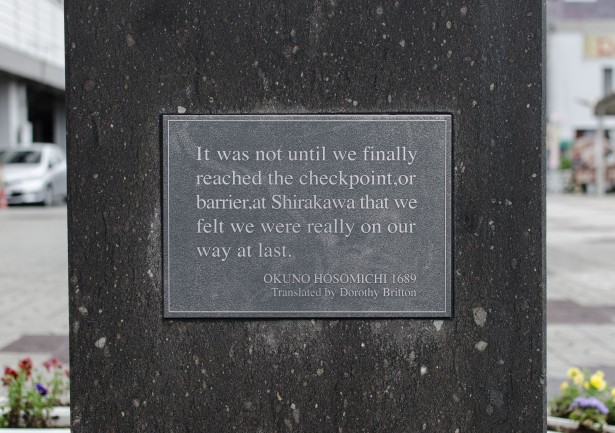
Taking the poet’s words to heart, on the way up to my present lodgings I stopped by at Shirakawa, once home of the barrier which divided the safe and civilised south from the lawless north. Not one to take the obvious course of calling a taxi, I set off on a roundabout route following the train tracks with only a highly stylised wall map with no visible scale to guide me on my way. Although the walk was very pleasant, allowing me a view of the town with traffic lights that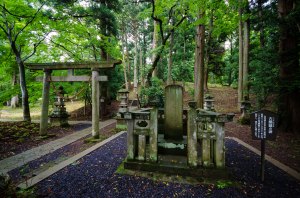 were literally (rather than figuratively) blue, as well as the steady spread of rice fields, after two hours I found myself in a park with an impressive mountain ridge and lake, but no sign of the (somewhat) famous Shirakawa no Seki. In the end I folded, took a taxi at great expense and was given an electric blue umbrella for my troubles. Remember kids, always check to see how far it is before walking.
were literally (rather than figuratively) blue, as well as the steady spread of rice fields, after two hours I found myself in a park with an impressive mountain ridge and lake, but no sign of the (somewhat) famous Shirakawa no Seki. In the end I folded, took a taxi at great expense and was given an electric blue umbrella for my troubles. Remember kids, always check to see how far it is before walking.
Hiraizumi
Number two was a village with a number of very old temple… foundations. It seems Japan was/is not the best place to be for ageing holy wooden structures, which, even in my experience, seem to have a habit of being knocked down by earthquakes or obliterated by fires, whether naturally occurring or caused by an angry monk who had a bone to pick. Thankfully there are other temples in the area, so up the scenic route I went only to find Call my hysterical, but I was rather unnerved, and put this to use by augmenting the bear-scaring noise made by hammering the block (most of which were almost completely broken) by practically bellowing any form of tune that sprang to mind, which ended up being a twisted mix of Frank Sinatra and Salve Regina. Despite barely coming across insects on the short walk up, I now feel far more worldly at having navigated bear-infested woods and feel sure that my plan of throwing everything in my camera bag at my oncoming assailant (it being a black bear) whilst sobbing quietly at the loss would have come off in my favour.
Call my hysterical, but I was rather unnerved, and put this to use by augmenting the bear-scaring noise made by hammering the block (most of which were almost completely broken) by practically bellowing any form of tune that sprang to mind, which ended up being a twisted mix of Frank Sinatra and Salve Regina. Despite barely coming across insects on the short walk up, I now feel far more worldly at having navigated bear-infested woods and feel sure that my plan of throwing everything in my camera bag at my oncoming assailant (it being a black bear) whilst sobbing quietly at the loss would have come off in my favour.
Yamadera
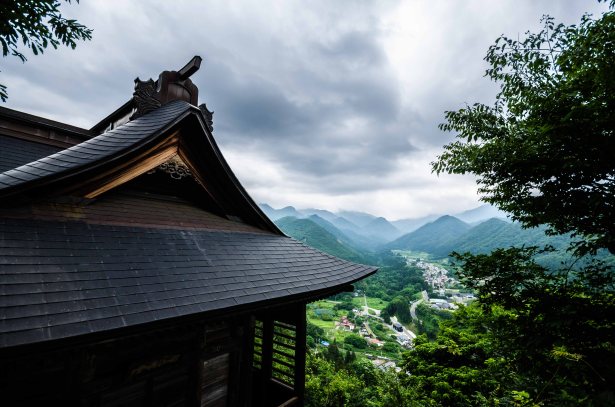 The most famous of the three, boasting a grand total of one foreigner (the only one spotted in three days — we shared a quiet nod of solidarity), Yamadera is so named because it features a large number of temples and, so it would appear, graves, on the side of a mountain, with the
The most famous of the three, boasting a grand total of one foreigner (the only one spotted in three days — we shared a quiet nod of solidarity), Yamadera is so named because it features a large number of temples and, so it would appear, graves, on the side of a mountain, with the town in the valley below. High heat and humidity, coupled with sporadic rain, did not make the journey on foot particularly pleasant. On the way, however, I was graced with a statue of my predecessor-of-sorts for some inspiration before visiting the nearby museum in his memory. There seems a slightly odd disparity between the number of Japanese people who know much of Oku no Hosomichi and the emphasis placed on the route by the locations mentioned, although perhaps my very presence in such places proves a point.
town in the valley below. High heat and humidity, coupled with sporadic rain, did not make the journey on foot particularly pleasant. On the way, however, I was graced with a statue of my predecessor-of-sorts for some inspiration before visiting the nearby museum in his memory. There seems a slightly odd disparity between the number of Japanese people who know much of Oku no Hosomichi and the emphasis placed on the route by the locations mentioned, although perhaps my very presence in such places proves a point.
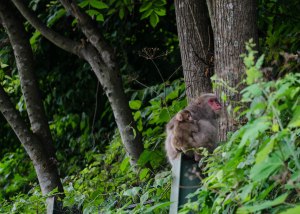 On the way up, I also encountered my first genuine real life wild Japanese monkey, who seemed rather unnerved at having a camera brandished at her, as indeed many of us would. She, along with the aforementioned bears and the strangely large and copious dragonflies brings the grand total of animals that my current hosts didn’t really believe we don’t have in England to three. I can only expect the total to increase from here on out.
On the way up, I also encountered my first genuine real life wild Japanese monkey, who seemed rather unnerved at having a camera brandished at her, as indeed many of us would. She, along with the aforementioned bears and the strangely large and copious dragonflies brings the grand total of animals that my current hosts didn’t really believe we don’t have in England to three. I can only expect the total to increase from here on out.

